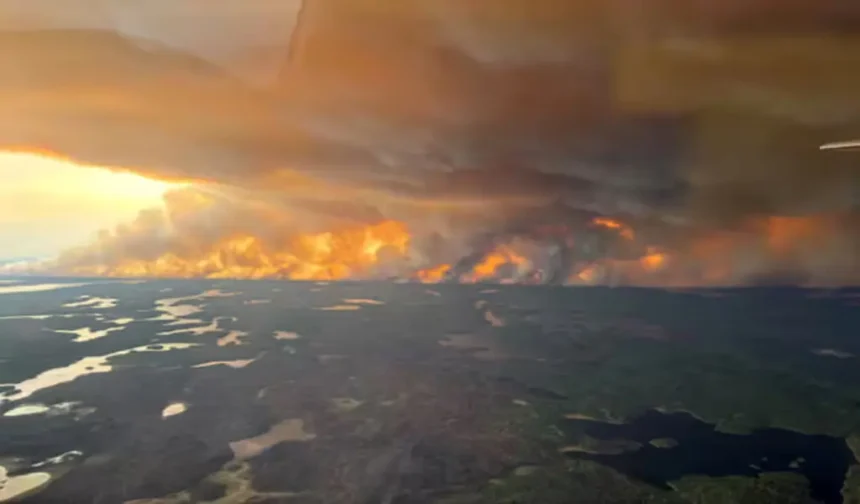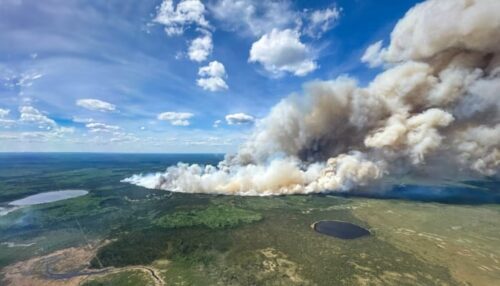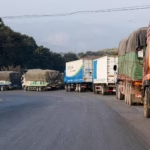Over 17,000 people have been evacuated in Manitoba, Canada, as wildfires force a state of emergency. Learn how climate change, extreme fire conditions, and military involvement are shaping Canada’s most intense wildfire season in years
As wildfire season intensifies in the western province of Manitoba, Canada, more than 17,000 people were evacuated on Wednesday due to the region’s most severe start in years.
“The wildfire situation has resulted in the Manitoba government declaring a province-wide state of emergency,” said Manitoba Premier Wab Kinew during a press conference. “This is the most extensive evacuation that Manitoba has experienced in the lifetime of the majority of its residents.”
Kinew confirmed he requested assistance from Prime Minister Mark Carney to deploy the Canadian military. Military aircraft will be used “imminently” to evacuate individuals from remote northern communities threatened by the flames. Additional firefighting resources are also being mobilized.
Canada’s Wildfires Becoming More Frequent and Severe
Due to the climate crisis, wildfires in Canada have grown more frequent and intense. The country suffered its most destructive fire season on record in 2023, and 2024 appears poised to follow suit.
Currently, 134 active fires are burning across Canada, including in British Columbia, Alberta, Saskatchewan, Manitoba, and Ontario. Half of these are considered out of control.
Flin Flon, a mining town named after a fictional character from a 1905 paperback novel, was among those evacuated. Its 5,000 residents had been warned to prepare to flee as a significant wildfire closed in.
Numerous Indigenous communities and remote towns were also ordered to evacuate, with most evacuees being relocated to Winnipeg, the capital of Manitoba.
Sheryl Matheson, who owns a fishing resort in the small community of Sherridon northeast of Flin Flon, said the fires have overwhelmed the area.
“It has been an overwhelming experience,” she said. “It was exceedingly smoky. The fires were visible from four to five kilometres away and were rapidly advancing.”
She added, “The flames were erupting at a height of over 121 feet, and firefighters couldn’t get close enough to fight it effectively.”
Elsaida Alerta told CBC she was experiencing “significant anxiety” as she prepared to leave Flin Flon with her family after living there for three years.
“This is certainly nerve-wracking, especially for someone who has never had to evacuate and has lived in a big city before,” she said.
Alerta described how the only operational highway out of town was congested and local stations had run out of diesel.
“We grabbed our essentials—medications, documents, pet supplies—and just hope for the best,” she said.
Climate Change Driving Unprecedented Fire Behaviour
Premier Kinew highlighted the alarming spread of wildfires across the entire province.
“For the first time, the fire is not confined to a single region; rather, it is present in all regions,” Kinew said. “That’s indicative of a climate that is evolving, and we will need to adjust accordingly.”
Manitoba is currently battling 22 active wildfires. Kirstin Hayward of the Manitoba Wildfire Service noted that nearly 200,000 hectares of forest have burned in the past month, tripling the five-year average.
“The prolonged period of warm and dry conditions in Manitoba has contributed to the highest fire activity in Canada so far this year,” Hayward said.
Thousands Evacuated, Firefighter Injured
Earlier this week, about 1,000 people from Lynn Lake and Marcel Colomb First Nation in Manitoba and 4,000 more from Pelican Narrows and nearby Saskatchewan communities were evacuated.
Tragically, a firefighter suffered serious injuries after being hit by a falling tree while battling the flames. He is currently receiving medical care.
Premier Kinew stated that emergency shelters are being established, and he called on businesses and communities across Manitoba to “open their doors” to displaced residents.
Two residents of Lac du Bonnet lost their lives earlier this month after being trapped in a wildfire northeast of Winnipeg.
















